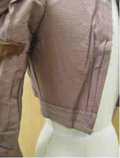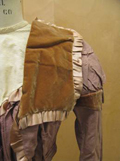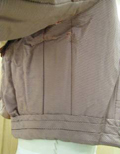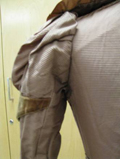This bodice, c.1892, would have been worn over a corset. According to Jean Hunnisett in Period Costume for Stage and Screen (1991), “The aim was to make the hips more rounded and the waist as small as possible, and to flatten the abdomen and encase the body in a more rigid and upright position.” It has the appearance of a bolero or Zouave jacket which became more popular in 1892, according to Norah Waugh in The Cut of Women's Clothes 1600-1900 (1968), who stated it “was more customary with the dressmaker style of costume.”
The materials used to make this bodice indicate a day dress. The fabrics are not delicate enough for an evening dress. This garment is made of light weight silk ottoman in two colors (pink and brown), silk ribbon, silk velvet, and brushed cotton.
During this period a stand collar would be included. However, this bodice is missing that piece. The revers are wide to emphasize the width of the shoulders. They are made of velvet, faced with ottoman and trimmed with silk ribbon. Waugh confirms that “Sleeves, revers, epaulettes, etc., were often of a contrasting colour and material, usually velvet…”. These revers are bagged out with the ottoman and attached by hand to the bodice. Bodices often had more decoration than the more plainly constructed skirts of this period.
Figure 1: Left Rever |
 |
The sleeves are cut in two pieces with a small puff at the top. “They were always mounted on a two–piece fitting foundation sleeve, and set high on the shoulders” (Waugh). The entire sleeve is flat lined to brushed cotton and has seams finished by hand with an overcast stitch. The puff is gathered to the under structure (flat lining) at the top of the cap and stitched across the bicep. The under sleeve (flat lining) has much less fullness across cap, but it still gathers in across the top. The outside sleeve front includes a detail at the bicep. The sleeve is partially lined with velvet and reversed to the outside to expose this contrasting fabric. It is then tacked down to the flat lining to secure the top of the piece. The cuff of the sleeve is finished with a gathered satin ribbon matching the lapels and a self fabric bias strip for the facing which is hand sewn inside.
Figure 2: Side View |
 |
The front of the bodice appears to be two garments belted together. Hunnisett suggests that similar bodices commonly had a “false bolero filled in with an imitation blouse or chemisette.” The bolero portion ends at the side seam. It is smooth across the waist at the sides then gathers towards center front. The “jacket” portion ends leaving center front open approximately two inches. The front opening is finished with a gathered silk ribbon from the belt to the revers. This opening is also finished with a self fabric facing piece slip-stitched to secure it on the underside. The facing is a straight piece of two-inch wide fabric with the selveges still attached. The fake “blouse” portion is stitched directly to the flat lining. This front section is gathered at the center front into the belted section and finished at the top with silk ribbon.
Figure 3: Bodice Front |
 |
Waugh states that by this time “…all bodices and blouses were still cut as before and were mounted on to a firm lining with all seams boned.” The under structure/flat lining is made of a brushed cotton. It has a slight sheen to the surface. The structure has two darts positioned under the bust running to the waist with bone tape backstitched to the dart. A third bone of the same length has been cross-stitched at center front. Two darts, one on each side of the body, are sewn from the armscye toward the bust points. Bones are also placed on the side seams and side back seams.
Figure 4: Inside View |
Figure 5: Boning |
 |
 |
Additional side back French-styled seams on each side of center back exist only in this layer for shaping across the back. They initiate at the waist and finish in the armscye. No bones are sewn to these seams. One bone has been cross stitched center back only on the side that the eye tape has been sewn.
All of the seams are finished by hand by turning under the ottoman fabric and trimming the flat lining to that width. Then, the fabrics are stitched together by hand using an overcast stitch. The bottom of the bodice is finished with a one and a half inch (1 1/2) wide piece of bias cut fabric and slip-stitched by down to the flat lining. The yoke is hand sewn to the flat lining and finished with a piece of matching bias tape. This tape would have been covered with the stand collar that was typical of the period but it is missing on this garment.
Figure 6: Underarm |
 |
The back of the bodice, unlike the front, appears as one garment belted at the waist. The side back seams finish into the armscyes. The center back opening is concealed with two pleats at top and bottom on either side of the closing. The ottoman is tacked to the flat lining every few inches down the center back to keep it from revealing the opening. The bodice closes with hook and eye tape.
Figure 7: Front Below Bolero |
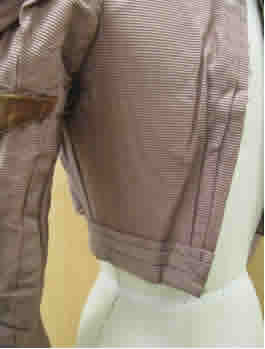 |
During the early 1890's, Hunnisett tells us that “the bottom of the bodice could be straight with a belt or have a slight dip at the centre front.” This belt is pleated like a cummerbund is constructed, with two pleats. On the top of the belt, the seam allowance has been turned down and it has been slip-stitched to the bodice. The bottom edge of the belt is attached in the same way.
Based on the research in Norah Waugh and Jean Hunnisett, it is likely that this garment can be dated c.1892.
© Jacki Blakeley Armit, 2009


